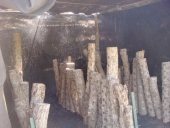posted 3 years ago
If you want to use straw, my advise is take a bucket or multiple buckets, and put a quarter inch bit in your drill. Drill 3 or 4 drain holes in the bottom of bucket, then holes 3-4” apart all over the bucket, staying 2” away from the top and bottom.
Get some straw. I like barley straw, followed by oat straw, then wheat straw. The wheat straw should be chopped. Put it in a clean garbage can, and use a weed eater on it. Wear goggles and a mask. Note, a single bale will fill 12-16 buckets.
Soak the straw for several hours, or overnight. Then remove it and let the excess water drain away. Now put about 2” of straw in the bucket and press it down. Add oyster spawn (I like the blue oyster, as it’s a good fruiter in all weather). Repeat this process until the bucket is full. Put on the lid and wait.
I did six buckets for a friend. They pinned after five weeks and my friend was harvesting after six weeks.
I plan to start six to eight buckets per month this year and hope to have oysters to eat all year.
25F7058A-2C0D-4681-913D-750572A7E4D6.jpeg
![Filename: 25F7058A-2C0D-4681-913D-750572A7E4D6.jpeg
Description: [Thumbnail for 25F7058A-2C0D-4681-913D-750572A7E4D6.jpeg]](/t/171530/a/163691/thumb-25F7058A-2C0D-4681-913D-750572A7E4D6.jpeg)
8CE9463F-4E9F-476F-AA48-A59773C86AEF.jpeg
![Filename: 8CE9463F-4E9F-476F-AA48-A59773C86AEF.jpeg
Description: [Thumbnail for 8CE9463F-4E9F-476F-AA48-A59773C86AEF.jpeg]](/t/171530/a/163692/thumb-8CE9463F-4E9F-476F-AA48-A59773C86AEF.jpeg)







